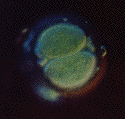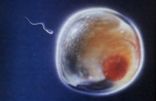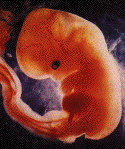WHAT ARE FROZEN EMBRYOS?
3 week old embryo at the blastocyst stage. |
Since the 1970s, in vitro fertilization has enabled infertile couples to become parents. The woman is given drugs to stimulate egg production. The eggs are harvested and placed in a lab dish (petri dish) with sperm. If fertilization occurs, embryos result. Generally, three or four embryos are placed in the uterus with the hope that at least one will implant (even though the others may die). The "leftovers" that were not place in the uterus are stored for later use. Please note that no matter how small they are, they are human and the researcherswant to keep them alive while they conduct these procedures. |
Questions and Answers on
Storing Frozen Embryos |
 30 hour old embryo! 30 hour old embryo! |
Q. Where are human embryos stored? |
A. Clinics and doctors' offices that treat people with fertility disorders generally store embryos on site. |
| Q. How developed are the embryos before they're stored? | A. It varies. Some clinics put them into storage as single cells, others as clusters of four or eight cells, others when they've grown to 60 or 100 cells, known as blastocysts. |
| Q. How are they kept alive? | A. They are stored in liquid nitrogen at minus 384 degrees. This puts them into a state of suspended animation. |
| Q. How long can they survive at that temperature? | A. There is no evidence so far that embryos die while stored at minus 384 degrees. |
| Q. What are they housed in? | A. They're kept in tiny straws that are about 6 inches long and 2 millimeters in diameter, designed specifically for holding frozen embryos. The straws hold between one and three embryos, suspended in about 2 cubic centimeters of a solution of salt water with nutrients - very similar to the medium found in a woman's uterus. The straws are contained within a squat round double-walled thermos that is wider at the base and narrower at the neck. That minimizes vaporizing of the liquid nitrogen. |
| Q. How many embryos can be stored in one thermos? | A. Several hundred. |
| Q. What kind of maintenance is required to keep the embryos alive? | A. Because the liquid nitrogen does turn to a gas and dissipate, it must be regularly replenished. Generally, if the lid isn't opened too often, a thermos full of nitrogen will maintain minus 384 degrees for about six months. |
| Q. What's the cost to store embryos? | A. Each clinic sets its own price. The cost most typically falls between $100 and $250 a year but in rare cases may reach $500. |
| Q. Who owns a frozen embryo, and what happens in the event of a divorce? | A. The donors of the egg and sperm own any resulting embryos. In case of a divorce, a judge would have to determine ownership. |
| Q. Are there any new techniques on the horizon? | A. Some clinicians have experimented with freezing slices of ovarian tissue, containing many immature eggs, and fertilizing it with sperm. However, few if any pregnancies have resulted. |
6 week old unborn child |
Source of Qs &
As: Michael Wilson, reproductive physiologist for the Reproductive Resource
Center of Greater Kansas City in the Kansas City Star; August 28, 2001 |


